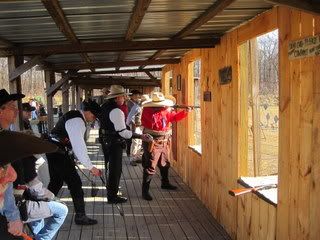

 The Accurate Reloading Forums
The Accurate Reloading Forums  THE ACCURATE RELOADING.COM FORUMS
THE ACCURATE RELOADING.COM FORUMS  Rifles
Rifles  Lever Action Rifles
Lever Action Rifles  win 94 to 454
win 94 to 454Go  | New  | Find  | Notify  | Tools  | Reply  |  |
| One of Us |
Would a Winchester 94 Trapper in 45 colt reamed to 454 Casull or 460 S&W handle the pressure? Seems to be around the 40-50,000 PSI range. Thought it would make a great gun for the scabbard in griz country | ||
|
one of us |
Sounds like an explosion in the making! | |||
|
| one of us |
Buck Elliot used to work for or with Freedom Arms. He posted this on the leverguns forum: "Just remember that pressure is always and only relative to the resistance of the system in place to contain it... If the pressure does not exceed strength of the containment apparatus, all is well. The Freedom Arms .454 revolver has a built-in 100%+ safety factor - that is, it will contain pressures in excess of 100% overload. That said - DON'T try to find out how much or how high that is... We did succeed in breaking a .454 at F.A., but only after much tedious loading and firing of ammunition no one could conceivably load by accident or mistake. The gun never did "blow up," it just finally "broke..." In my own .454 levergun tests, back in the late '80s, we did manage to ruin a few Winchester '94s, and one Marlin 336. The Marlin failed after the fewest rounds of factory-equivalent ammo, digesting only a handful of rounds (somewhere short of 20, if memory serves...) before the action would no longer lock up safely or securely. Next to fall was a brand-new Winchester '94 Big-Bore AE, which stretched and flowed like taffy, as the bolt tried to climb up the locking lug and out of the top of the receiver, peening the lug recesses in the receiver terribly, and noticeably stretching the right side wall of the receiver. In their infinite wisdom, Winchester (USRAC) beefed up the receiver in the wrong place, while cutting ALL the strength out of the right receiver wall, to allow for their ill-conceived "angle ejection" modification. The '94 that performed best in my testing was a well-used carbine, made in the 1920s. It was still tight and crisp when we screwed the .454 barrel into it, but even it became dangerous and unserviceable in fewer than 50 rounds. The whole point of the testing was to prove to various and sundry doubters that the 1894 Winchester was NOT a suitable platform for the powerful .454 Casull round - and WHY. The guns used (and used up...) in the tests were donated to the cause by those very Doubting Thomases...! It doesn't get much better than that. BTW, the same Sharon barrel was used in all the tests, and it emerged unscathed. It was finally rethreaded and rechambered to .45 Colt and installed in a Browning '92, where it still resides -- a 24", octagon beauty. The 1894 and 1895 Winchesters are NOT particularly strong actions, having llooooooonnnnngg receiver walls and angled, rear locking bolts. In short, physics and geometry are against them from the outset. As mentioned above, the '94 AE suffers the further indignity of having the only strengthening metal available to it REMOVED to make way for the abominable ejection system. The '86/M-71 and '92 Winchesters are by far the strongest of the "traditional" lever actions, with the nod going to the '86/71, with its square-to-bore vertical lockup, which situates the lugs about 2/3 the distance back from the breech-face as compared to a '94 or '95. The '86's receiver walls are robust and not chopped up or hollowed out as are those on the '94, in particular. The new Browning/Winchester 1886 and Model 71 are virtually identical offerings, made of good, through-hardened steel, and will serve as the basis for some VERY powerful loading. Be careful, and don't try this at home... Regards, Buck" | |||
|
| One of Us |
Thanks for the info, guess I'll have to shop for a 450 marlin guide gun. Johnson | |||
|
| one of us |
Or get the Rossi Winchester 92 clone which they sell in 454 Casull. | |||
|
| Powered by Social Strata |
| Please Wait. Your request is being processed... |
|

Visit our on-line store for AR Memorabilia

